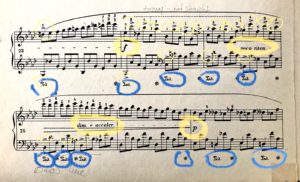The other day I was playing through Chopin’s Impromtu Op. 29 #1, a piece I memorized and first performed about 20 years ago. The music was open in front of me and I noticed something “new” to me: a poco riten., followed by dim. e accelerando marking in measures 24-26, repeating later. Of course, it wasn’t really new, I just never paid attention to this specific instruction before. So I followed Chopin’s prompt and all of a sudden there was an added thrill of speeding up and getting softer at the same time; the passage was transformed. Executing the expression marking precisely resulted in a very satisfying musical experience.
Early music scores don’t contain many specifics but dynamics, accents, tempo changes and mood indications gradually proliferated. Looking at only the 6 selected bars of the Impromtu, you can see how much exacting information Chopin cared to put in. There are 4 dynamic markings, 2 tempo changes, 11 pedaling indications and 22 accents. As a piano teacher, I regularly remind students to pay careful attention to all of the information in the score, yet I have my own moments of laziness, losing my focus and neglecting to process the text mindfully.
Reading music carefully is a simple concept but it’s not easy to implement. Some questions to ask yourself are: have I noticed every Italian term on the pages, do I know what each of them means? If I don’t, will I remember to look them up later or perhaps I better do it now? The same goes for the French in Debussy or the German in Schumann, for instance. Did I register every dynamic change? How about accents, pedaling and rests? Do I really take adequate time for all the silences and fermatas? Last but not least, some analysis, harmonic and melodic, could be very useful. Franz Liszt used to make his students look at a piece carefully BEFORE learning the notes, so they could see the forest for the trees. That approach was genius – why don’t we all follow suit, starting today?

